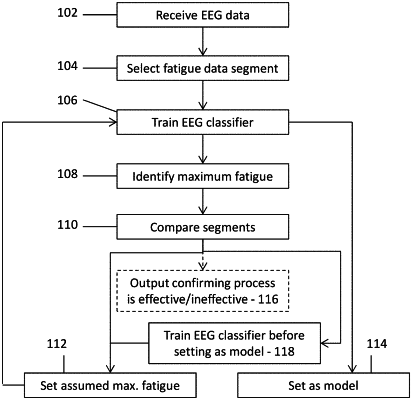| CPC A61B 5/165 (2013.01) [A61B 5/18 (2013.01); A61B 5/316 (2021.01); A61B 5/369 (2021.01); A61B 5/7267 (2013.01); A61B 5/0006 (2013.01); A61B 5/163 (2017.08); A61B 5/374 (2021.01)] | 18 Claims |

|
1. A computer system for establishing an electroencephalogram (EEG) model for discriminating between alert and fatigue states, comprising:
a receiver module for receiving:
an alert state segment illustrative of an alert state of at least one subject; and
one or more EEG fatigue data segments illustrative of a fatigue state of the at least one subject;
a segment selector for selecting one of the one or more fatigue data segments and setting it to be an assumed maximum fatigue segment;
an EEG classifier trainer for training an EEG classifier by extracting an EEG feature space from the alert state segment and assumed maximum fatigue segment based on the alert state segment and assumed maximum fatigue segment defining respectively opposite ends of a fatigue spectrum;
a maximum fatigue identifier module for identifying a segment of maximum fatigue by applying the EEG classifier to each of the fatigue data segments;
a segment comparator for determining if the segment of maximum fatigue is consistent with the assumed maximum fatigue segment;
a limit setter for:
setting the segment of maximum fatigue as a revised assumed maximum fatigue segment, if the segment of maximum fatigue is inconsistent with the assumed maximum fatigue segment; and
supplying the EEG classifier trainer with the revised assumed maximum fatigue segment, and using the EEG classifier trainer to train the EEG classifier by extracting an EEG feature space from the alert state segment and revised assumed maximum fatigue segment based on the alert state segment and revised assumed maximum fatigue segment defining respectively opposite ends of a fatigue spectrum; and
a model output module for setting the EEG classifier as the EEG model for discriminating between alert and fatigue states in segments of EEG data.
|